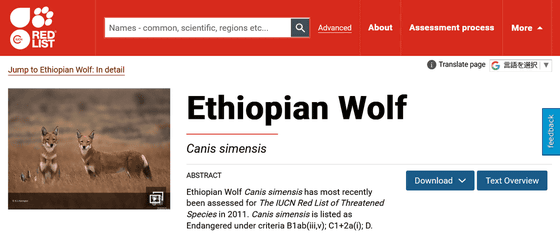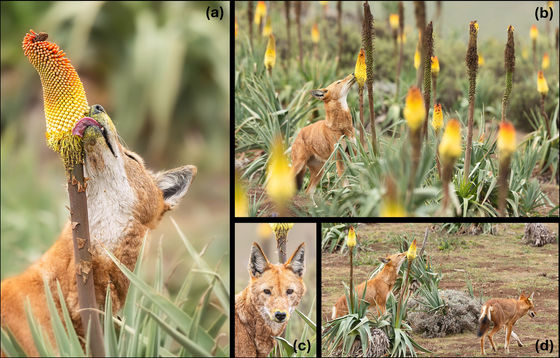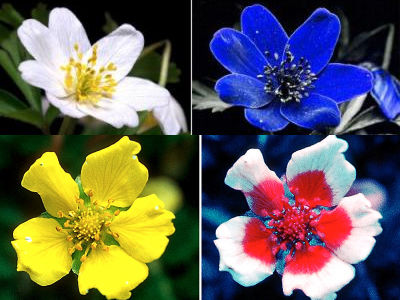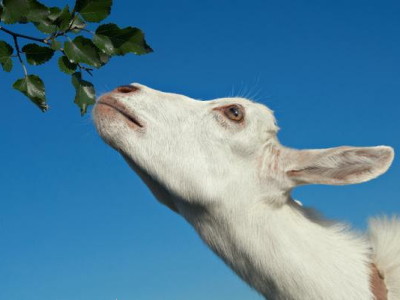Study reveals that endangered wolves play a role in pollination cycle just like bees

Honeybees, which feed on nectar, fly from flower to flower to collect nectar, carrying pollen and mediating pollination. Such animals are called
Canids as pollinators? Nectar foraging by Ethiopian wolves may contribute to the pollination of Kniphofia foliosa - Lai - 2024 - Ecology - Wiley Online Library
https://esajournals.onlinelibrary.wiley.com/doi/10.1002/ecy.4470
Wolves with a taste for nectar? How we discovered the first large carnivore that pollinates flowers
https://theconversation.com/wolves-with-a-taste-for-nectar-how-we-discovered-the-first-large-carnivore-that-pollinates-flowers-245234

Some plants are wind-pollinated, like cedar trees, where pollen is carried by the wind, while others, like seaweed, are water- pollinated , where pollen is dispersed by water currents, but about 90% of seed plants are animal-pollinated. Bees are the most well-known animal pollinators, and bees such as honeybees and bumblebees are said to be involved in about 80% of seed plants. In addition to bees, butterflies and moths are also insect pollinators.
Bats play an important role as non-insect pollinators. In addition, some nectar-feeding birds, lemurs, and lizards are also known to be pollinators of some plants. Pollinator mammals are small to medium-sized and often arboreal , while only a few carnivorous mammals have been identified.
A study published in November 2024 by Sandra Lai, a postdoctoral researcher at the Ethiopian Wolf Conservation Program at the University of Oxford, and her colleagues observed Ethiopian wolves, large carnivores, collecting nectar from flowers.
According to Lai, the Ethiopian wolf lives only in high-altitude areas of the Ethiopian rainforest, with fewer than 500 confirmed to be alive as of the end of 2024. The Ethiopian wolf was listed on the International Union for Conservation of Nature's Red List in 2011.

A conservation program run jointly by Oxford University and Ethiopian experts has been working to protect the Ethiopian wolf for over 30 years. According to Claudio Cillero, founder and director of the program, Ethiopian wolves were observed eating nectar during the conservation program many years ago. 'I watched the wolves zigzag between the flower beds, licking the bright red and yellow flowers before moving on to the next one with binoculars from behind a rock,' Cillero said. 'I knew the flowers were full of sweet nectar, but I never thought wolves would love sweet things too.'
The impetus for Lai's research came from a photo taken over two years by photographer Adrien Lesar, who had heard that Ethiopian wolves eat nectar. Lai and his team discovered that the wolf in the photo had pollen on its nose. After further investigation, they found that the case in the photo was not an exception, and that Ethiopian wolves spend a long time in the flower fields, moving between about 30 different flowers while carrying pollen.
Below, the Ethiopian wolf, as shown in the paper, eats the nectar of the Ethiopian chickweed flower.

'Our study challenges conventional thinking about plant-pollinator interactions, especially with regard to the role of predators,' said Rai. 'Most pollinator mammals are bats, with only small carnivores being identified. Omnivorous bears such as the Malayan sun bear also feed on nectar, but this has rarely been documented. That's why it's groundbreaking to be able to observe the behavior of the Ethiopian wolf in such detail.'
Although the Ethiopian wolf has been observed to carry pollen, it has not yet been confirmed whether it plays the role of an effective pollinator. Future research will require an investigation into how much the behavior of the Ethiopian wolf contributes to ecosystem processes, said Lai. In addition, since the Ethiopian wolf is not necessarily the only example of a large carnivore acting as a pollinator, it is expected that observing the behavior of other plants and animals will further deepen our understanding of ecosystem processes.
Related Posts:
in Creature, Posted by log1e_dh







